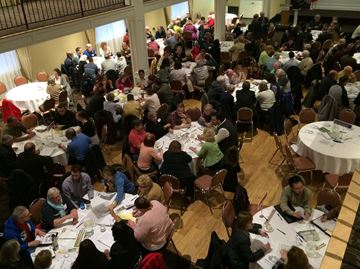
Creating a livable, walkable community and providing incentives to farmers were just two of the many ideas that came out of a public meeting on provincial land use.
On Wednesday, hundreds of residents from across the Greater Toronto and Hamilton Area gathered at the Milton Banquet Hall to share ideas about the Provincial Growth Plan for the Greater Golden Horseshoe, the Greenbelt Plan, the Oak Ridges Moraine Conservation Plan and the Niagara Escarpment Plan.
The Ministry of Municipal Affairs and Housing and the Ministry of Natural Resources and Forestry organized the meeting. It was the 12th of 16 public meetings on the issue.
“The plans we have in place are good. We should be proud of them. They protect our environment, agriculture and natural resources. But there’s always room for improvement,” said Larry Clay, assistant deputy minister and Ontario growth secretariat for the Ministry of Municipal Affairs and Housing.
Discussion topics for those in attendance included protecting agriculture, land, water and natural areas, transit and infrastructure, climate change, building communities, attracting workers and creating jobs, improving implementation and better aligning the plans. Members of the public sat at tables designated to a certain topic and talked among themselves before presenting their ideas to the entire room.
The big takeaways were recommendations that with a region expecting to grow by 4.5 million people in the next 25 years, urban growth needs to be more carefully managed to get people out of their cars and encourage a livable, walkable community, and that farmers who own protected lands need more freedom and incentive to operate their businesses.
One fruit farmer from Beamsville, Torrie Warner, commented that because his land was located in the greenbelt, a 1.8-million acre strip of protected forests, farmlands and wetlands, his property is devalued because it’s essentially undevelopable.
“My neighbours property (not in the greenbelt) could be worth $100,000 per acre whereas mine is $10,000,” he said.
Another table spoke about the inability for farmers to build small installations on their land, as it could contravene provincial legislation. The result would be massive development charges or poorly-situated constructs. For instance, a shelter is required by law to be built 120 m away from wetlands, which could potentially mean it’s placed in the middle of a property.
“It just doesn’t make sense,” said an audience member.
As for urban growth, audience recommendations included a firmer commitment from all levels of government to improve transit and infrastructure, a re-evaluation by the Ministry of Transportation of the location of highways, a better understanding of ‘intensification’ and a consistent policy framework to guide regional and provincial growth.
At the municipal level, members of the audience suggested lifting stringent zoning restrictions to allow for more mixed-use developments and high-density employment. They also suggested designing communities as pedestrian-friendly by improving accessibility to major amenities and integrating natural heritage features.
Other ideas included more options for affordable housing, better transportation and encouraging more outdoor activity.
Halton MPP Indira Naidoo-Harris, who was at the event, said, “these sessions are about building today for a future tomorrow and ensuring we are leaving a property legacy for our children.”
The recommendations will be taken back to Queen’s Park for a review among all provincial ministries. An advisory committee will come back with a formal report highlighting the key takeaways of the public information sessions by September 1.
------------------------------------------------------- ------------------------------------------------------- ---------------
Detail Link :
http://www.insidehalton.com/news-story/5574922-residents-share-ideas-at-milton-meeting-on-provincial-land-use/
